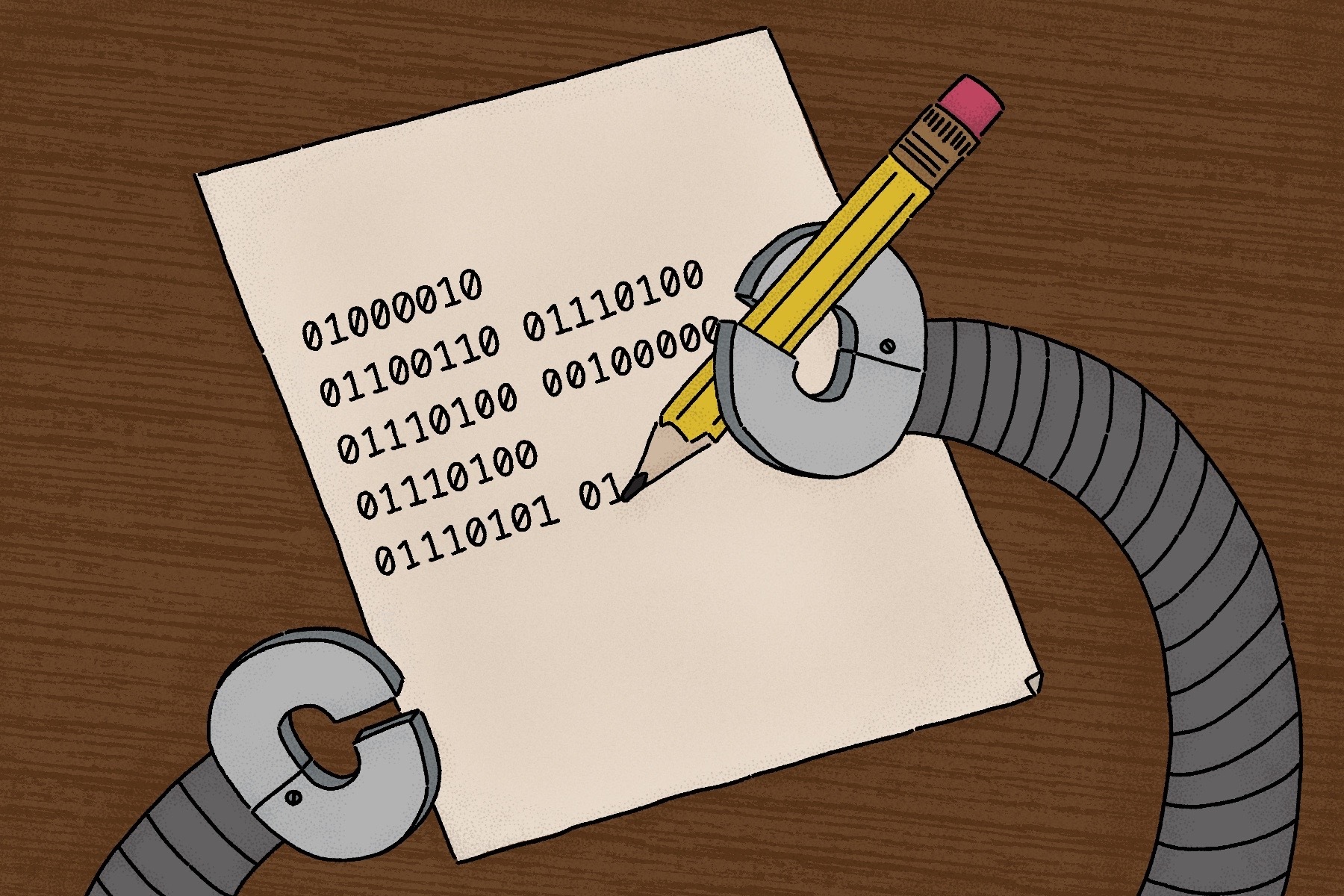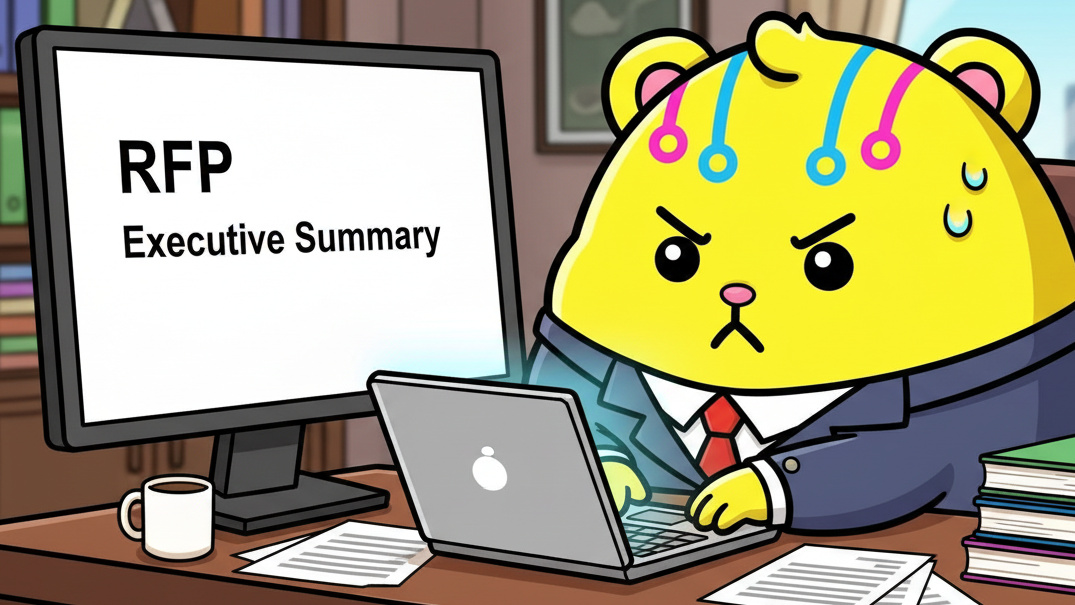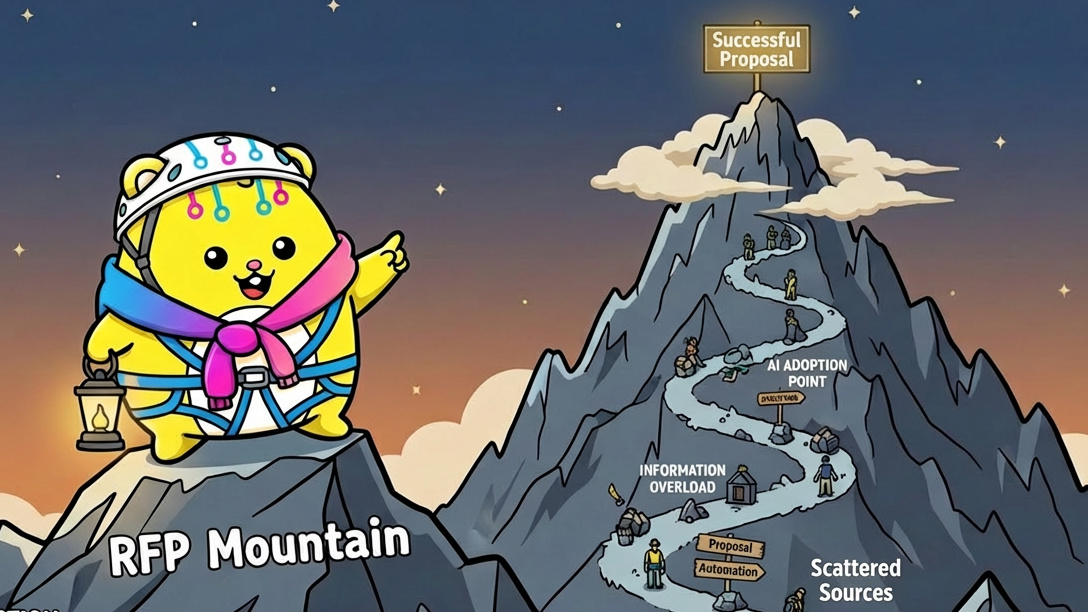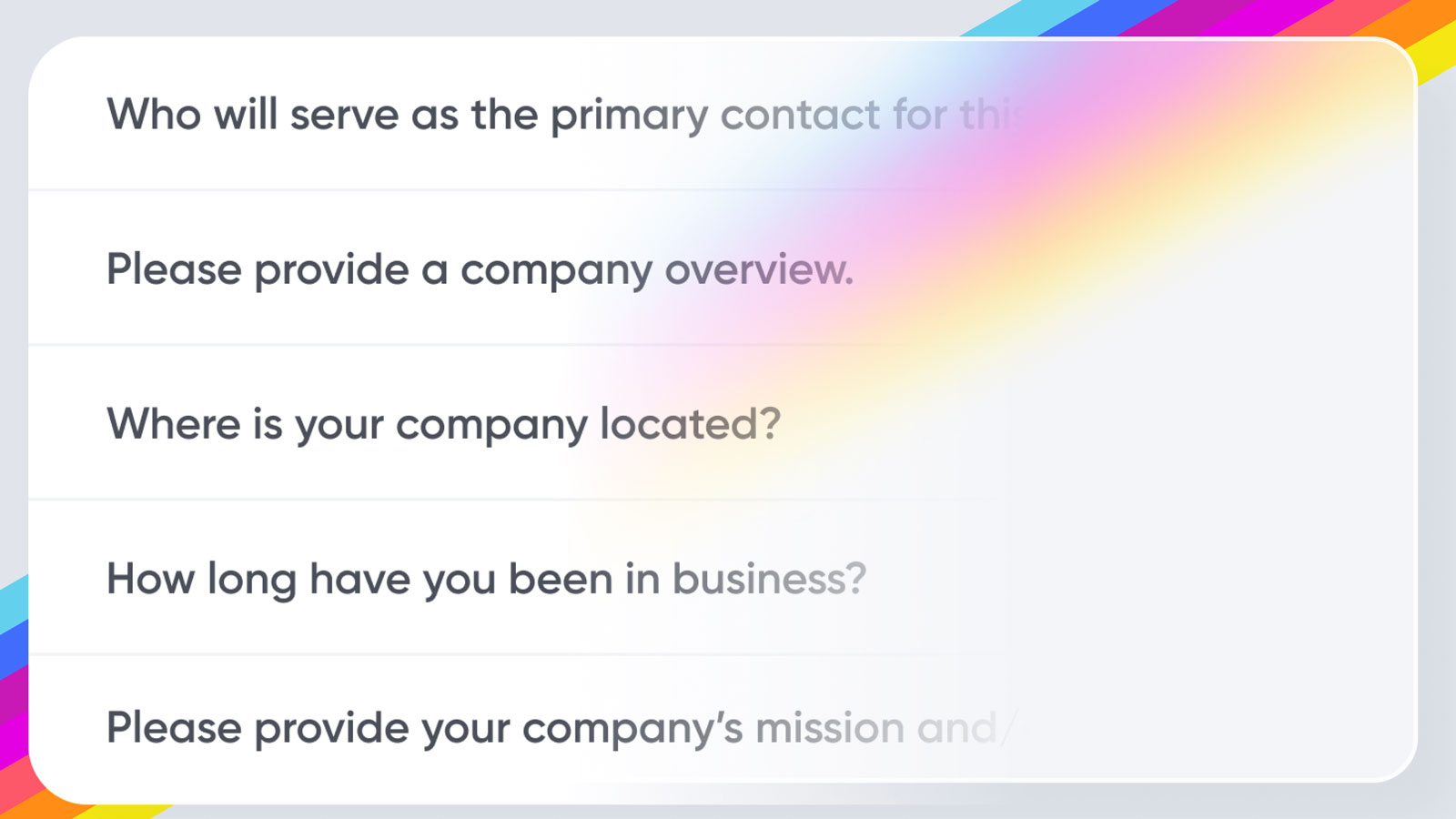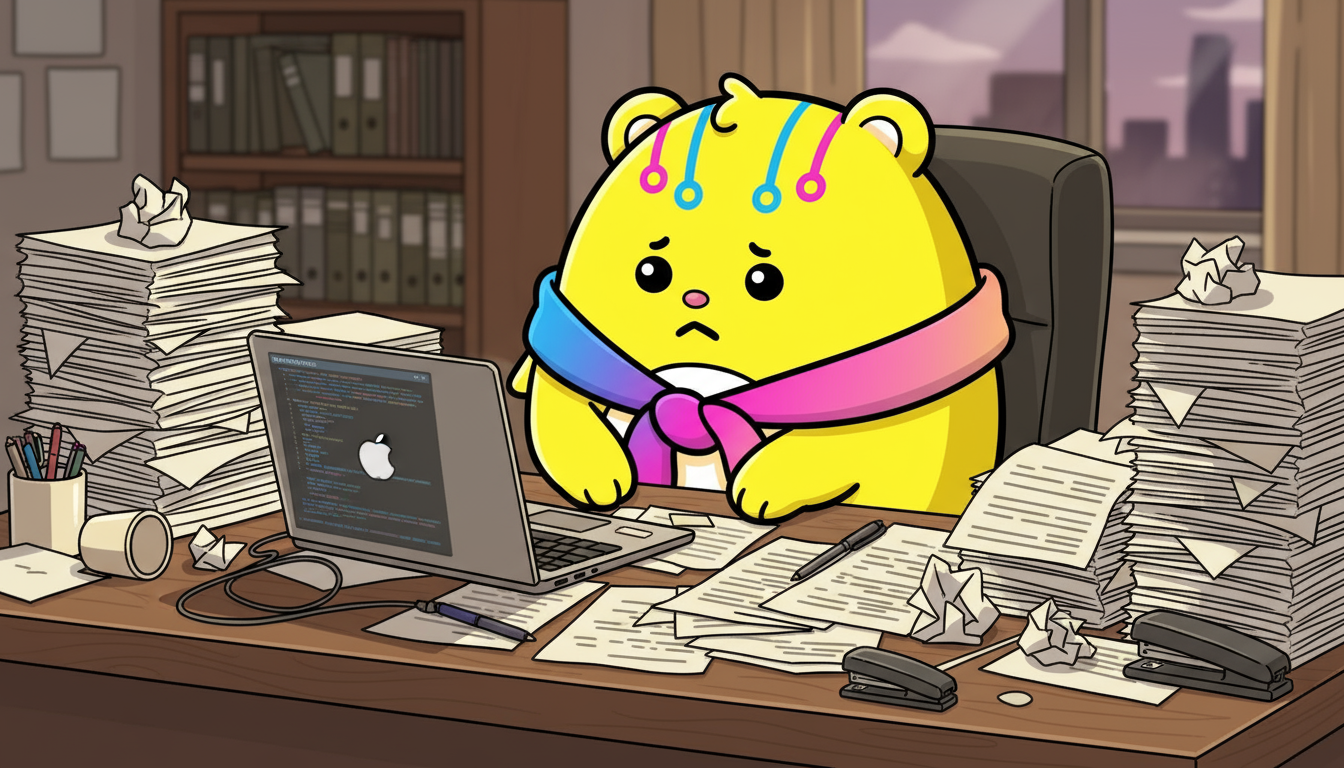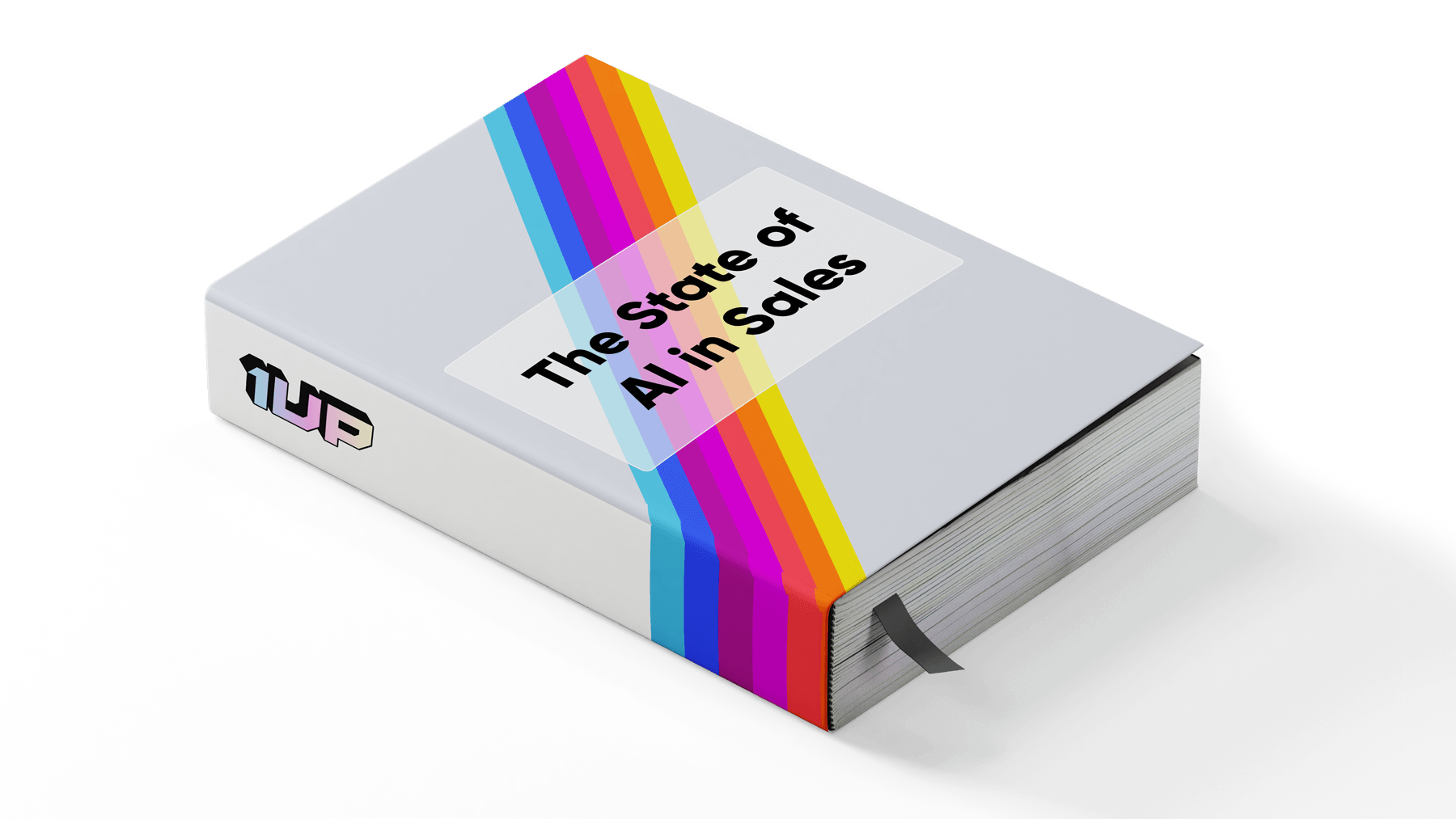You’ve got an RFP, and it has a tight deadline. There is a mind-numbing amount of sections to be filled out. What do you do? Panic? Cry? Contemplate a career change?
(Maybe a little.)
Sure, you can panic a little. Maybe scream into a pillow for a few minutes. But once the meltdown’s over, it’s time to actually fill the thing out.
This grueling process usually takes days. And, often comes with a lot of mistakes (since you’re only human). And you can’t afford that.
So, you turn to generative AI. But (most) AI lies, it hallucinates, and it’s so wordy!
In this guide, we’ll talk about the RFP process, the challenges of generative AI RFPs, and more. The good, the bad, and the ugly.
Key Takeaways
- An RFP is a document sent by a company that needs a product or service to companies that may be able to provide that service.
- Because they can take a team days to complete, it makes sense to want to use AI to automate many of these tasks.
- Large Language Models (LLMs) like 1up are changing the process of responding to RFPs by automating repetitive tasks and providing answers up to 10x faster.
- Solely on automation isn’t enough. To ensure accuracy and maintain quality, teams still need to review, refine, and align the responses with the specific needs of each client.
What is an RFP?
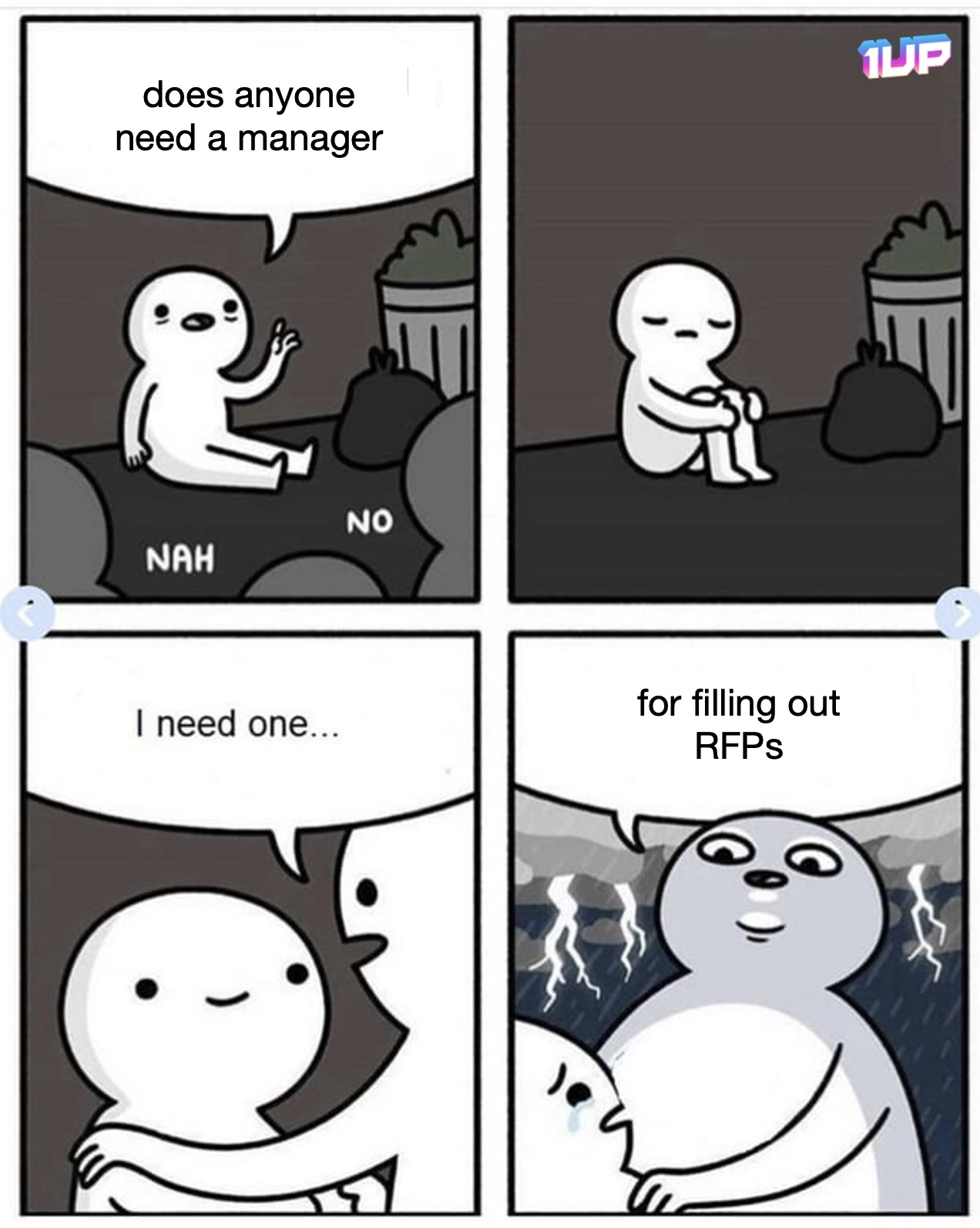
An RFP is the term we use for a Request for Proposal. Usually, a company will send several RFPs out to competitors to see who will submit the best bid. “Best” in this case could mean price, but it often includes other factors like your vision, timeline, and team.
Types of RFPs
Virtually every industry uses RFPs, including:
- Business
- Government
- Technology
- Construction
You might also see different styles of RFPs.
Open RFP
First, there’s an open RFP, which a company sends out to a bunch of vendors.
An open RFP casts a wide net.
Closed RFP
There’s also a closed RFP, which goes out only to a select few candidates.
A closed RFP is more exclusive, and you’ve probably already been in touch with the company.
There are also structured RFPs vs. Narrative-driven, free-form RFPs
Structured RFP
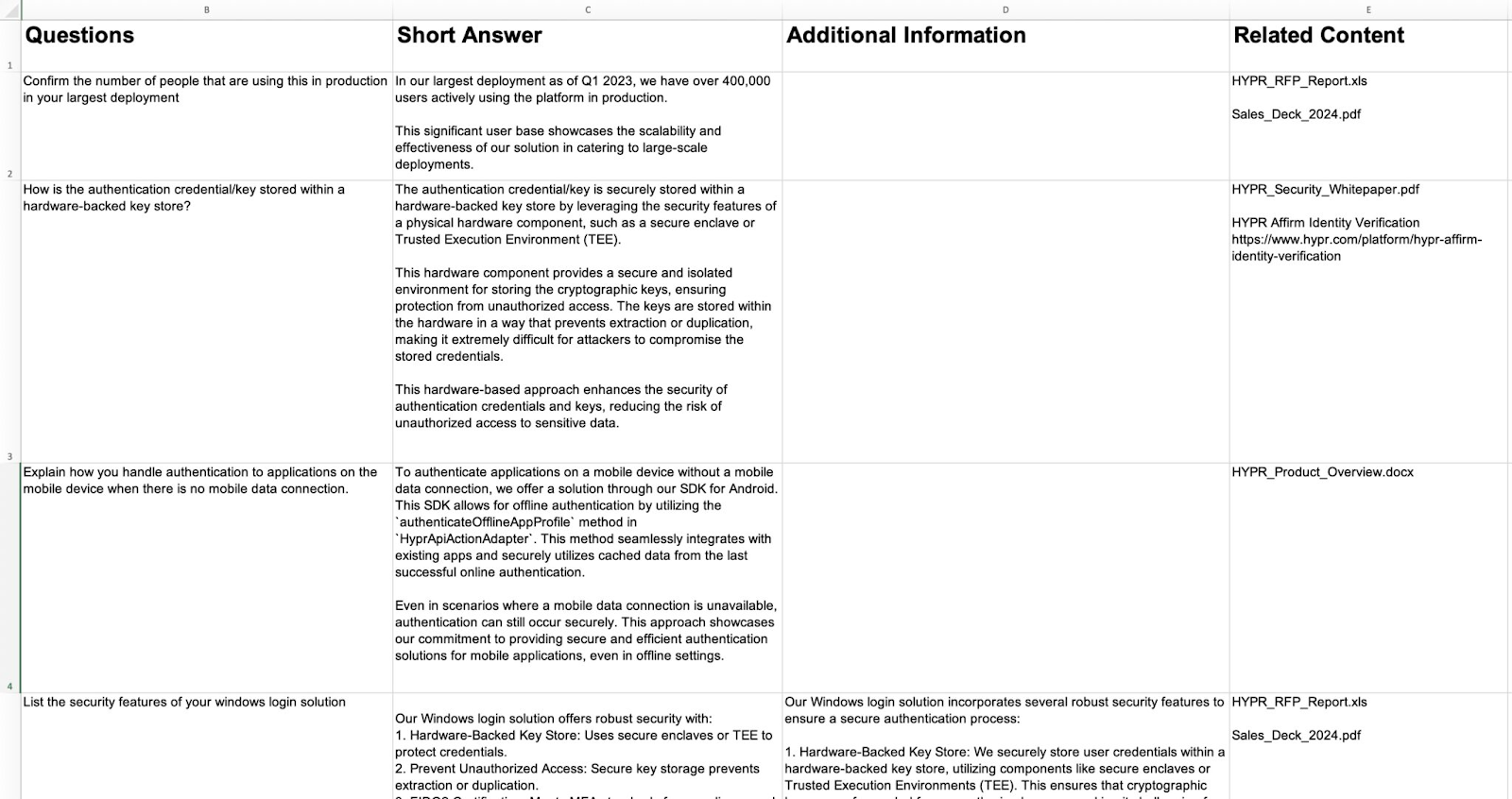
With a structured RFP, you’ll see clearly outlined sections to be filled out. This allows the company to send out the RFPs to more easily evaluate each proposal side-by-side.
Narrative-driven RFP
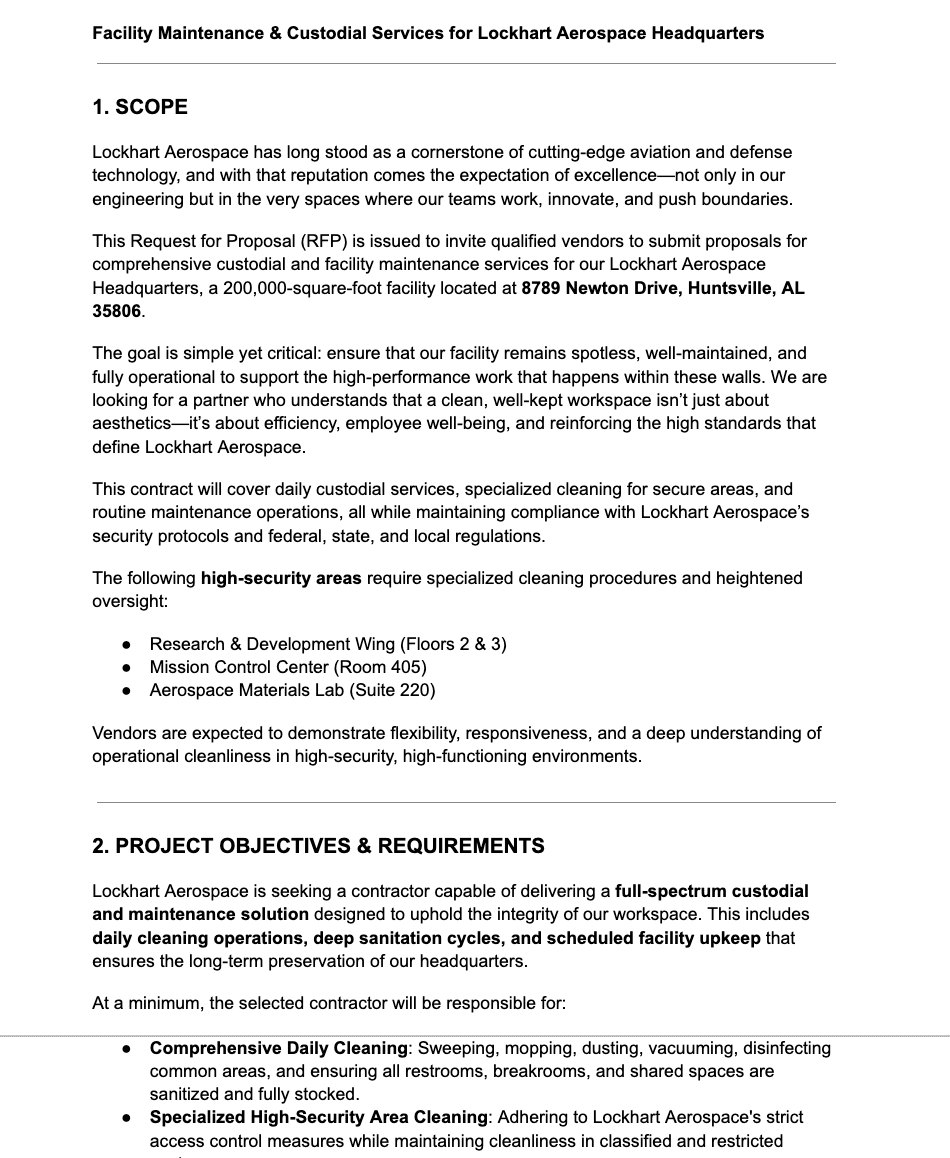
A narrative-driven RFP will be just what it sounds like, more free-flowing and less predictable. It’s driven by a story, either about the client, the company submitting the proposal, the project, or all three.
Due Diligence Questionnaire

Finally, you’ll often see a due diligence questionnaire or a DDQ. These are often the most thorough documents you’ll see in the realm of large, RFP-like documents. While a DDQ is not technically an RFP, it is a doc that may come across your desk for similar reasons.
A DDQ is sent out when a company is preparing to partner with another company. It is a long and involved document, like a security questionnaire, that inquires about compliance and risk factors. It’s focused on the long-term viability of the company.
When submitting a proposal or bid, you may also be submitting a DDQ. Large private companies or the government often only want to do business with companies that are stable and strong.
Sections of an RFP
Regardless of the type of RFP, you’ll almost always find a structured document that includes these sections:
- Announcement of the project
- Description of the project
- A request for your company’s bid
- Guidance on how to fill out the RFP
When Do You Need an RFP?

Most of the time, you’re at least slightly aware that an RFP is coming your way. Maybe you’ve heard this potential client is looking for bids. You might have insider information that you’re in the running for the bid.
The bottom line is this: a company needs a product or service they can’t provide for themselves. They need an outside business to provide it. And you might be just the organization for the job.
But now you have to prove yourself.
Your responses to the RFP will help your potential client determine:
- Your company’s ability to complete the project to their satisfaction
- Your company’s financial health
- The practicality of your bid
So, when do you need it? Sometimes right away. Ah, yes, the nightmare RFP. The client sends over an RFP out of nowhere with a tight deadline, and you’ve got to jump into action.
If you’re curious how enterprises are tackling these responses, watch the video below of Pradeep Nayar at WalkMe for his advice on how to avoid the nightmare RFP:
Prad’s wisdom tells us the key ingredients are preparation and automation. More on this later.
RFP Process Overview
The RFP process essentially involves a company sending out a document to vendors to request proposals and choose the best one. Your goal is to have the best bid.
So, once you’ve gotten the RFP, the clock starts ticking. You want to win the bid, of course, and generating all the right answers quickly means a lot of stress.
Your sales team needs to be at their best, and you absolutely need proposal management.
Oftentimes, your entire sales team will need to see the RFP and understand each section and its questions. They also need to know where to find the right answers.
You might assign different sections to different members of your team, depending on their expertise.
Whatever your approach, it’s going to be a long, drawn-out process that is a pain in the ass.
The goal? To outbid your competitors. If only there was a way you could spy on them…
What’s Difficult About the RFP Process?
Where do we even start?
- RFPs ask questions your sales reps may not have answers to.
- Your “experts” might not actually be up to date.
- If your company is big enough, different teams might give completely different (and conflicting) answers.
- You might be working on multiple RFPs at once. (Lucky you!)
The reality is that RFPs are often the most tedious and difficult part of selling.
Why?
Because you need to be knowledgeable and able to respond to a lot of questions, sometimes hundreds of them. It’s a process that, in this day and age, should be optimized.
How AI Is Changing the RFP Process
In recent years, sales teams have been able to rely on automation for their RFPs. Systems like ChatGPT, CoPilot, and Claude can help your reps respond more quickly to certain parts of an RFP. This gives the reps time to edit, correct, and fine-tune the documents before they go out.
These systems can scan through mountains of data and generate answers faster than you can say, “Let’s circle back on that.”
And it can perform mind-numbing, repetitive tasks in minutes that can take hours of time for your team members.
Now, businesses can use AI to answer questions on RFPs.
Don’t just take our word for it—check out this demo to see exactly how 1up can level up your RFP workflow.
To avoid the “nightmare RFP”… we want to automate a chunk of the work. This gives us time back so we can focus on response quality, understand the context behind the RFP, and making the response package look perfect.
Pradeep Nayar, Global Bid Manager @ WalkMe
Impact of AI on RFPs
Of course, this automation means companies across the board can save time, streamline their processes, and increase efficiency on both sides of the RFP.
Plus, when it’s done right, RFP AI systems like 1up can ensure that answers to RFPs are accurate and precise.
Success Story
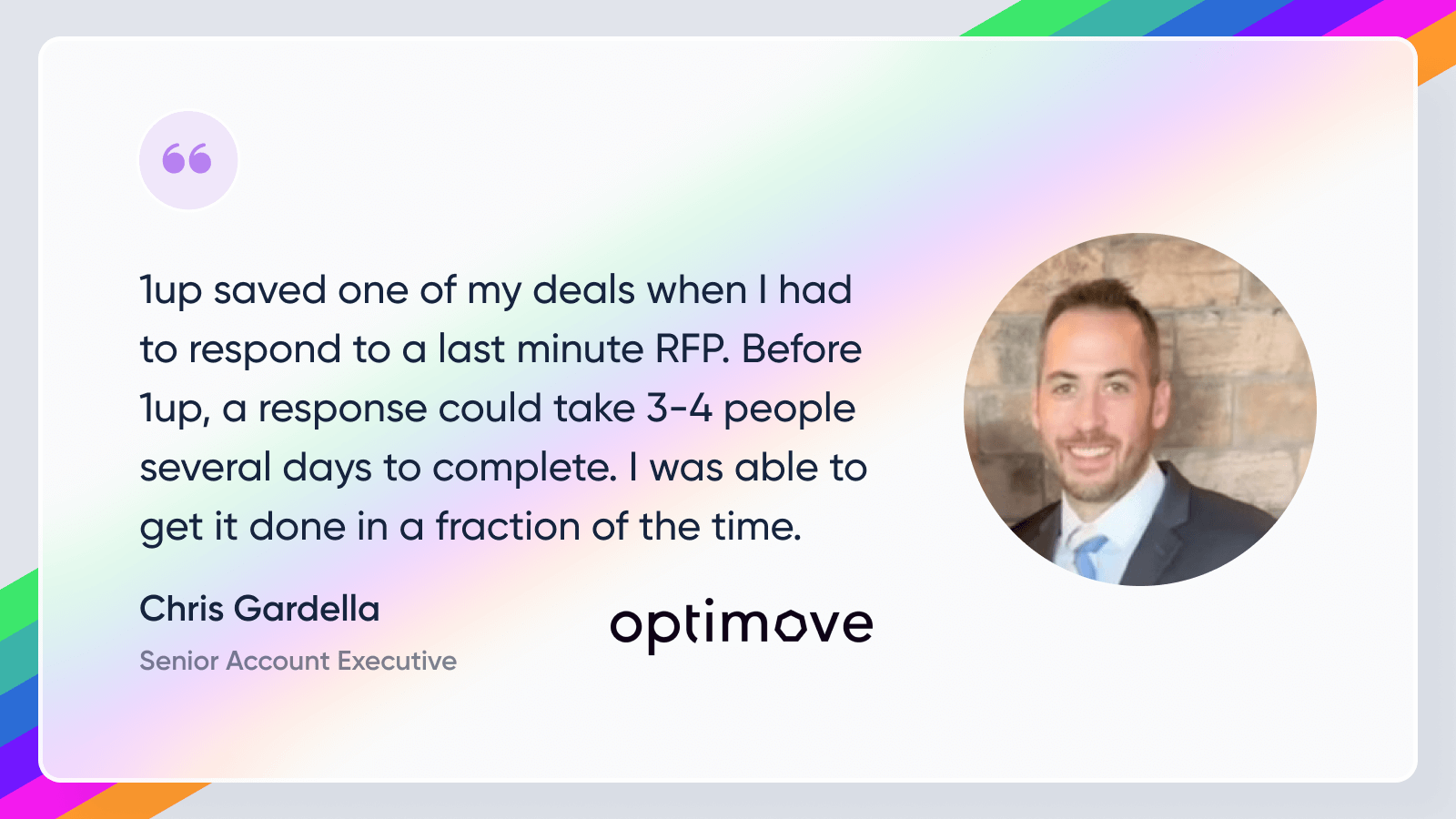
Optimove built a reputation for enabling brands to put their customers first. And their training to earn this legacy is incredible. They have so much information for their team members to draw on!
The only problem was that Optimove had so much information for their team members to draw on!
That’s right. The company’s excellence was getting in its own way because there was so much to learn.
Then, 1up teamed up with Optimove to automate and streamline their process. We tied all their knowledge sources together and provided a single knowledge base for all team members to pull from.
AI helped Optimove become a fully automated knowledge base.
Now, their sales team has all the information they could ever need right at their fingertips. And they can produce responses quickly and trust the source.
The Challenges of Using AI for RFPs
Trusting the source is one of the biggest challenges for using AI when it comes to RFPs. How can you be sure you have the right information?
We asked this question a while back, when we were wondering whether generative AI was really ready for the RFP process.
Our conclusion?
Yes. With guardrails. Here’s why:
AI lies a lot
Generative pre-trained transformers (GPTs) are, in essence, an advanced form of autocomplete text generation. Good for writing responses to RFPs. And also bad for writing responses to RFPs.
That’s because generative AI is prone to hallucination and making things up.
Steve de Mamiel, managing director at Sedin Technologies, adds that:
“The issue is that most AIs provide a generalized response rather than a specific answer to a customer’s problem.”
This is probably the fastest way you can lose a bid and is unacceptable when it comes to responding to sales questionnaires, especially when you’re asked about important product capabilities, security, or compliance requests.
The worst part is – AI sounds really confident when it’s lying to you. This makes it even more difficult to spot the inaccuracies and address them.
This is why it’s essential to use an AI like 1up which sources knowledge directly from your internal docs, website, and more, so you know everything is accurate. Want to see what it looks like in live action? Schedule a demo call here.
I don’t need to question the sources when 1up gives me an answer. This confidence allows me to chunk large questionnaires and take them on in smaller bites throughout my day.
Kahlil Lewis, FusionAuth Sales Engineer
It’s hard to teach new things to your AI
Getting answers wrong is bad enough. Making it difficult to teach your AI new things can make matters even worse.
Most language models are based on a large set of pre-trained data. Training a custom model is an expensive process that most businesses will never touch. Fine-tuning is much more accessible, but it’s unrealistic to do this every time you have new information.
For example, your answers to a compliance questionnaire might change on a quarterly basis. Product updates and new features might impact your responses as well. How do you teach your AI all of these updates in a fast, easy, and cost-efficient manner?
So you’re left with augmenting the AI with information from your business in the form of files, URLs, and 3rd party websites. Traditional copilots don’t make it easy to pull this data in, or to correct wrong answers when they come up.
That’s where 1up changes the game. With 1up, teaching K.B., our AI, new information or correcting answers is fast, simple, and intuitive. Need to add updated compliance answers or new product details? Just upload the source material, and 1up’s AI does the rest—linking back to the original documents. Got a wrong answer? Correct it on the spot, and our AI, K.B. learns immediately.
Chatbots are single-threaded
When responding to an RFP questionnaire, you often need to be able to have multiple projects running at the same time. For example, a compliance questionnaire, security assessment, and product capabilities matrix might be multiple sheets in a single document or separate parts entirely.
What’s great about humans is that they can multi-task. This makes it all the more surprising when you find that Generative AI chatbots are often single-threaded. Filling out hundreds of rows in an Excel sheet or responding to pages of questions in a Word Doc is not what they’re designed to do. And this defeats the whole purpose of using AI in the first place.
So you end up having to ask a single question at a time, hoping you’re getting accurate responses, and then having to fact-check them anyway. A single-threaded chatbot is not a great user experience when it comes to proposal management.
This is a big reason we created 1up, to solve this pain in the ass. With 1up, you can upload a complex Word Doc, Excel sheet, and you’ll get instant responses to all of them with information you can trust. See how it works for yourself here.
Key Considerations When Integrating AI into RFPs
The conclusion that we came to as a result of our investigation into generating RFP responses in the AI era is that we still need humans. In reality, we will likely always need humans.
We have built a powerful, smart, fast AI system at 1up. We have an AI that can in fact deal with complex documents and offer correct answers from trusted sources.
But we still need humans:
- To perform the fine-tuning
- To edit
- To correct wrong answers
- To upvote correct answers
- To update documents
- To provide context
- To ensure security measures are taken
- To use AI as a tool
Humans are the essential ingredient when it comes to using AI. The goal should be for AI to become better and better at supporting humans. AI can automate and it can perform repetitive tasks. It cannot be as intuitive as a human.
We need you for that.
Easy human-in-the-loop augmentation
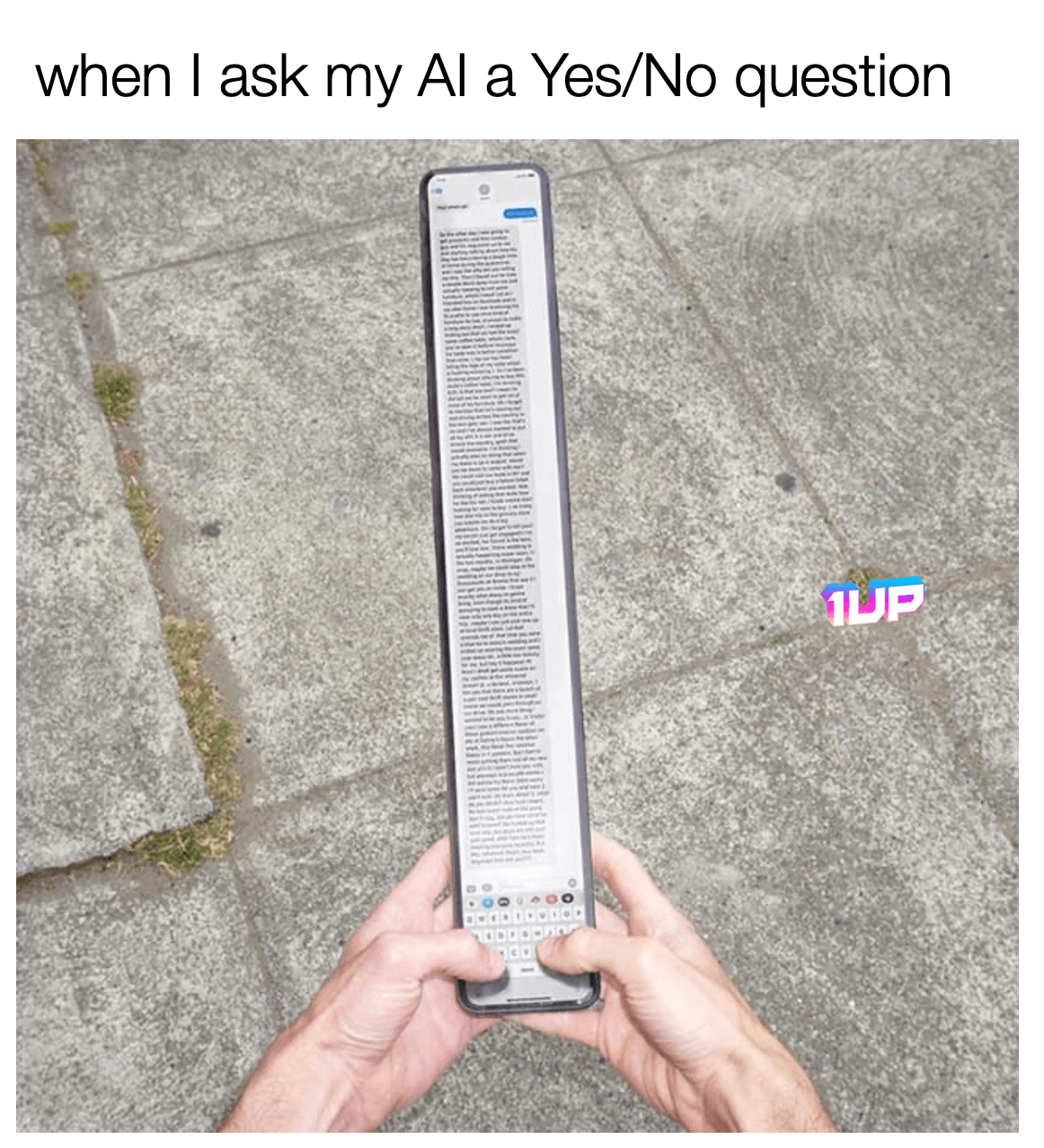
To address the challenges AI presents with RFPs, we need to keep a human in the loop.
AI chatbots do a great job of memorizing short-term inputs, but they can’t be easily corrected when they get something wrong.
Here’s how humans can help when it comes to RFPs and sales questionnaires.
- Editing, improving, and correcting responses on a per-answer basis. This should be easy and intuitive from the tool’s interface, with immediate results. It should not take a long time to re-train the AI on what the right answer would be.
- Overriding previous answers in bulk. This is especially important If you’re cranking out dozens or hundreds of RFP responses you’re more than likely already updating answers to previously asked questions. Generative AI RFP tools should be able to take this information and immediately learn from it without forcing the user to manually review old Q&A.
- Upvoting good answers. A user feedback loop is essential to any AI-generated response tool. Positive signals indicate that an answer was good and can be replayed in the future. This is how you can reinforce what “good” means to a system that’s otherwise unaware of how well it’s performing.
Speed, security, and parallelization
On the security and privacy side, if your team is worried about uploading sensitive data to an LLM then you can forget about automation. Sensitive information is the foundation of any good RFP response. If your team is hesitant about using it, you won’t get very far.
Speed is a big factor, too. You should be able to have multiple questionnaires running in parallel without having to worry about a tool’s capacity. This is important for demonstrating the value of an AI over a human – multi-tasking is expected of any software solution.
Check out our RFP software buyer’s guide, where we dive deeper into performance benchmarks and other qualities to look out for.
1up Your RFP Process with AI
In the end, AI can be a helpful tool when it comes to RFPs. Instead of panicking, frantically emailing teammates for answers, and pulling all-nighters, you can let 1up handle all the heavy lifting for you.
1up combines the above learnings to generate professional enterprise RFP responses while giving users the ability to:
- Connect many sources of information
- Generate hundreds of answers in minutes
- Block uncertain or incorrect responses
- Correct and improve answers based on human input
- Run many questionnaires in parallel
- Tag teammates and collaborate to resolve unknown answers
With 1up, teams are able to automate the response process while ensuring a high standard of data quality and accuracy.
With 1up, you get fast, accurate, and reliable responses pulled straight from your company’s own knowledge base. No hallucinations, no nonsense—just answers you can trust.
So, why keep suffering with unreliable RFP responses? Learn what you can do with 1up demo here.
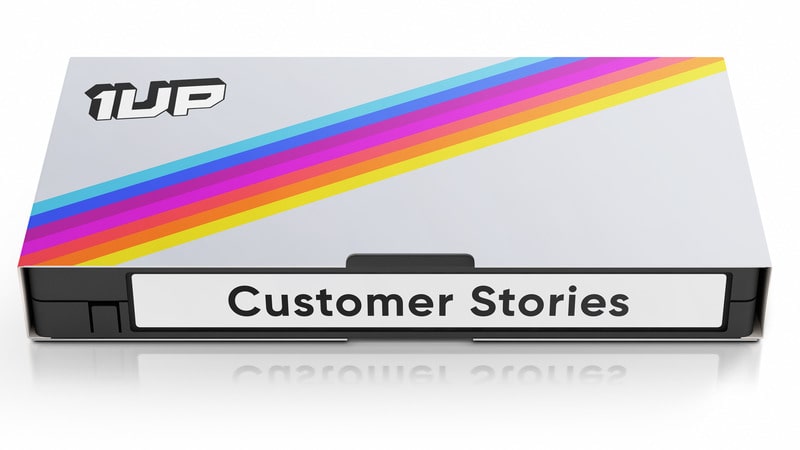

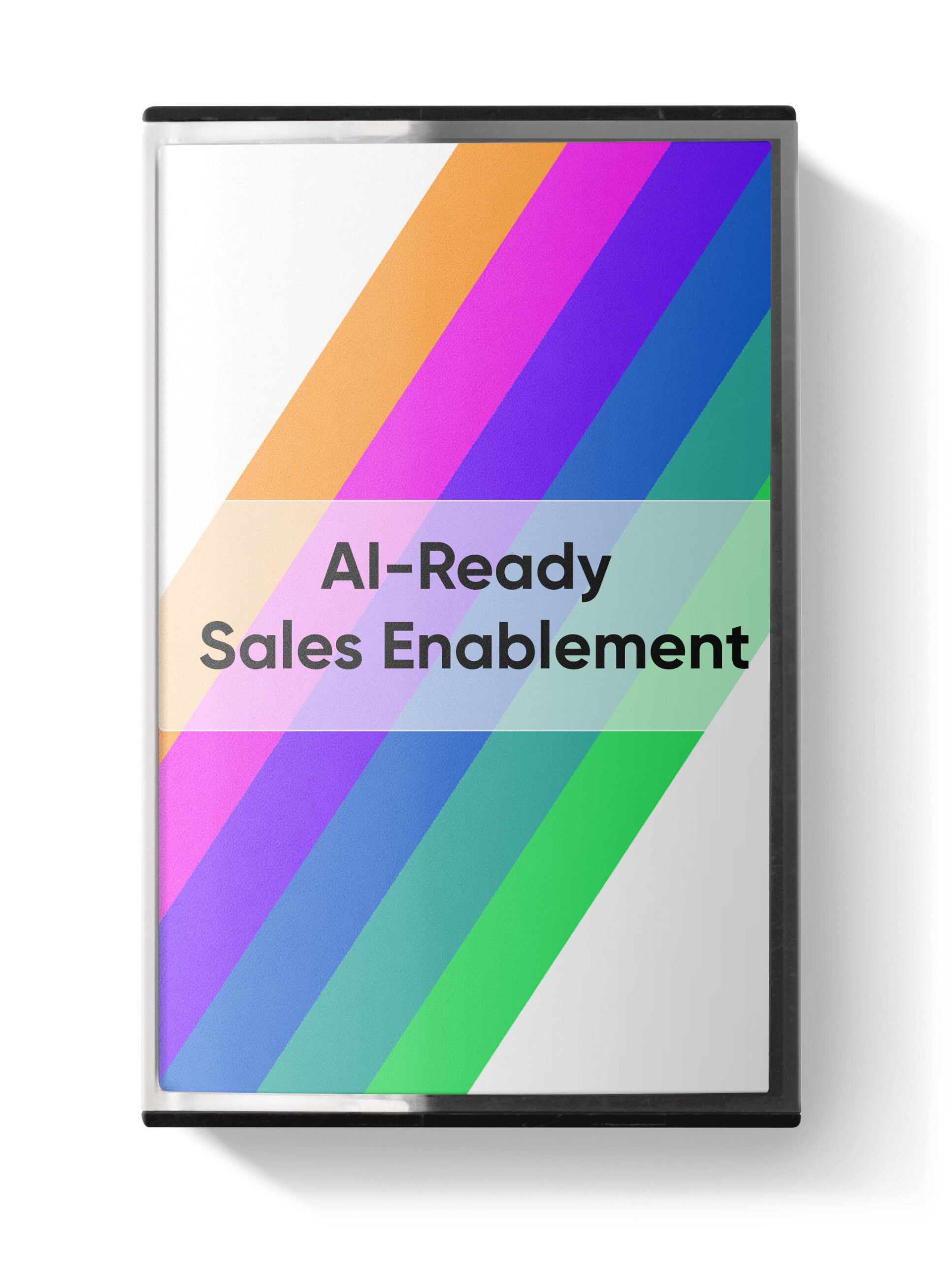
 Instagram
Instagram 


